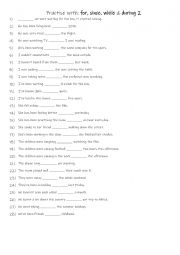|
Printables |
PowerPoints |
Online exercises |

|
A2+-B1 Practise with ever, since, just, yet, for & already 2
First, students need to familiarise themselves with the 6 adverbs and their use. Then they read the sentences to work out which one is needed to complete the gap-fill. Each adverb is used 5 times! Answers on page 2.
Level: elementary
Age: 9-100
Type:
Downloads: 101
|

|
A2+-B1 Practise with ever, since, just, yet, for & already 3
First, students need to familiarise themselves with the 6 adverbs and their use. Then they read the sentences to work out which one is needed to complete the gap-fill. Each adverb is used 5 times! Answers on page 2.
Level: intermediate
Age: 10-100
Type:
Downloads: 114
|

|
A2+-B1 Practise with ever, since, just, yet, for & already 4
First, students need to familiarise themselves with the 6 adverbs and their use. Then they read the sentences to work out which one is needed to complete the gap-fill. Each adverb is used 5 times! Answers on page 2.
Level: elementary
Age: 9-100
Type:
Downloads: 117
|

|
A2+-B1 Practise with ever, since, just, yet, for & already 5
First, students need to familiarise themselves with the 6 adverbs and their use. Then they read the sentences to work out which one is needed to complete the gap-fill. Each adverb is used 5 times! Answers on page 2.
Level: elementary
Age: 7-100
Type:
Downloads: 133
|

|
A2+-B1 Practise with for, since, while & during (2)
Learning to use for, since, during, and while is important because these words help student�s express time accurately in English, especially when talking about the duration and timing of events. For indicates the length of time an action takes place, while since pinpoints when an action started and continues until now, helping to show continuity. D...
Level: intermediate
Age: 9-100
Type:
Downloads: 111
|

|
A2+-B1 Practise with for, since, while & during (3)
Learning to use for, since, during, and while is important because these words help student�s express time accurately in English, especially when talking about the duration and timing of events. For indicates the length of time an action takes place, while since pinpoints when an action started and continues until now, helping to show continuity. D...
Level: intermediate
Age: 9-100
Type:
Downloads: 100
|

|
A2+-B1 Practise with future continuous or future perfect 1
Students should learn the future continuous and future perfect tenses as they are essential for discussing future actions with precision. The future continuous is used to describe actions that will be in progress at a specific time in the future, making it ideal for expressing plans, predictions, or expectations (e.g., This time tomorrow, I�ll be t...
Level: intermediate
Age: 10-100
Type:
Downloads: 103
|

|
A2+-B1 Practise with future continuous or future perfect 2
Students should learn the future continuous and future perfect tenses as they are essential for discussing future actions with precision. The future continuous is used to describe actions that will be in progress at a specific time in the future, making it ideal for expressing plans, predictions, or expectations (e.g., This time tomorrow, I�ll be t...
Level: elementary
Age: 9-100
Type:
Downloads: 102
|

|
A2+-B1 Practise with future continuous or future perfect 3
Understanding these tenses allows students to communicate future goals, schedules, and timelines effectively, enhancing both their speaking and writing skills for academic, professional, and everyday use. First, students need to familiarise themselves with the 2 tenses and their use. Then they read the sentences to work out which tense is needed t...
Level: intermediate
Age: 9-100
Type:
Downloads: 121
|

|
A2+-B1 Practise with future continuous or future perfect 4
Understanding these tenses allows students to communicate future goals, schedules, and timelines effectively, enhancing both their speaking and writing skills for academic, professional, and everyday use. First, students need to familiarise themselves with the 2 tenses and their use. Then they read the sentences to work out which tense is needed to...
Level: elementary
Age: 9-100
Type:
Downloads: 111
|
|
|
|
|












